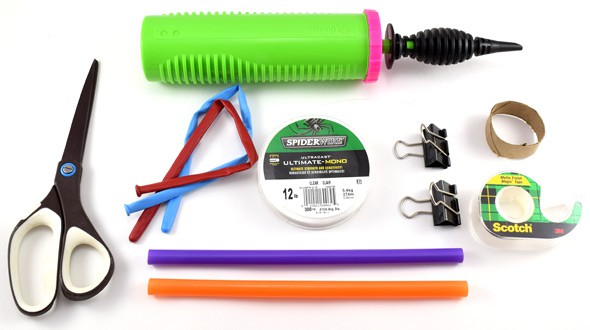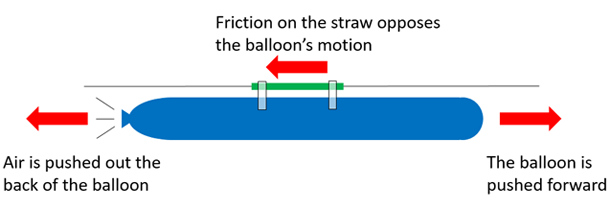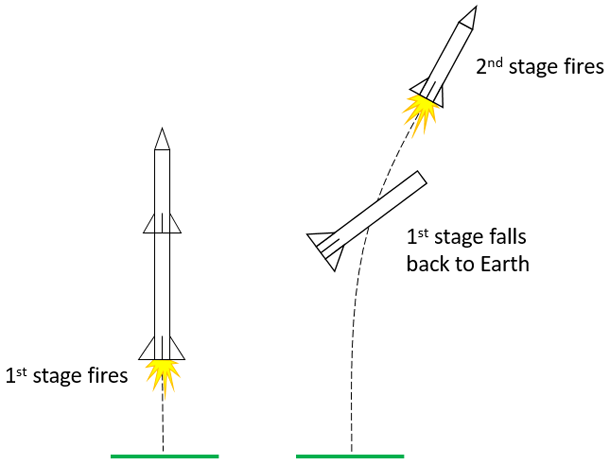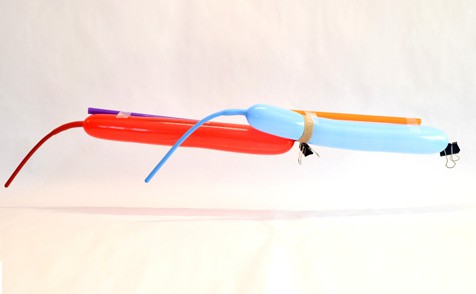Two-Stage Balloon Rocket
Summary
Overview
Learn about real space flight and Newton's laws of motion with this fun lesson! This new twist on a classic project lets your students build a multi-stage balloon rocket that they can launch across the classroom.Learning Objectives
- Understand how Newton's laws of motion apply to rocket flight
- Use the engineering design process to optimize a rocket design
NGSS Alignment
This lesson helps students prepare for these Next Generation Science Standards Performance Expectations:- MS-PS2-2. Plan an investigation to provide evidence that the change in an object's motion depends on the sum of the forces on the object and the mass of the object.
- MS-ETS1-3. Analyze data from tests to determine similarities and differences among several design solutions to identify the best characteristics of each that can be combined into a new solution to better meet the criteria for success.
|
Science & Engineering Practices
Asking Questions and Defining Problems. Plan an investigation individually and collaboratively, and in the design: identify independent and dependent variables and controls, what tools are needed to do the gathering, how measurements will be recorded, and how many data are needed to support a claim.
Analyzing and Interpreting Data. Analyze and interpret data to determine similarities and differences in findings. |
Disciplinary Core Ideas
PS2.A: Forces and Motion. The motion of an object is determined by the sum of the forces acting on it; if the total force on the object is not zero, its motion will change. The greater the mass of the object, the greater the force needed to achieve the same change in motion. For any given object, a larger force causes a larger change in motion.
ETS1.B: Developing Possible Solutions. Sometimes parts of different solutions can be combined to create a solution that is better than any of its predecessors. |
Crosscutting Concepts
Cause and Effect. Cause and effect relationships may be used to predict phenomena in natural or designed systems.
Patterns. Graphs, charts, and images can be used to identify patterns in data. |
Materials
 Image Credit: Ben Finio, Science Buddies / Science Buddies
Image Credit: Ben Finio, Science Buddies / Science BuddiesMaterials needed for a balloon rocket include: multiple balloons, an air pump, scissors, straws, fishing line, tape, a cardboard tube, and binder clips.
Materials per group of 2–4 students:
- Modeling balloons (2), available from Amazon.com. These are the long, skinny kind of balloons used to make balloon animals. Have some extras ready in case some balloons pop.
- Balloon pump (included with the balloons from Amazon.com, can be shared among multiple groups)
- Milkshake straws (2), available from Amazon.com
- One inch section cut from cardboard paper towel tube
- Fishing line or smooth string, available from Amazon.com (one spool should be enough for entire class)
- Large binder clips (2)
- Clear tape or masking tape
- Scissors
- Tape measure
Background Information for Teachers
This section contains a quick review for teachers of the science and concepts covered in this lesson.A classic "balloon rocket" project uses a single balloon taped to a straw and attached to a piece of string (Figure 1). When you inflate the balloon and then release its nozzle, air is expelled out the back of the balloon. According to Newton's third law of motion (for every action there is an equal and opposite reaction), this means the balloon is pushed forward along the string. Friction between the string and the straw acts opposite the direction of motion. The balloon's acceleration depends on its mass and the sum of these forces (Newton's second law, force = mass × acceleration).
 Image Credit: Ben Finio, Science Buddies / Science Buddies
Image Credit: Ben Finio, Science Buddies / Science BuddiesA balloon is taped to a straw which rides along a piece of string. When air escapes the balloon the balloon is propelled forward while the escaping air is forced backward, the friction on the straw also acts as a force opposite of the direction of travel of the balloon.
Figure 1. A basic balloon rocket.
This lesson expands on the traditional activity by adding a second stage to the balloon rocket, modeled after how real rocket launches work (Figure 2). It takes an enormous amount of energy (and therefore, fuel and money) to send a payload into space. In a two-stage rocket launch, the first stage lifts the rocket through the initial phase of its flight. Then, after its fuel is depleted, it breaks away and falls back to earth, while the second stage continues its flight. This saves energy because the depleted first stage is not carried all the way into orbit, allowing the second stage to travel farther with less fuel.
 Image Credit: Ben Finio, Science Buddies / Science Buddies
Image Credit: Ben Finio, Science Buddies / Science Buddies
Figure 2. Diagram of a two-stage rocket launch.






